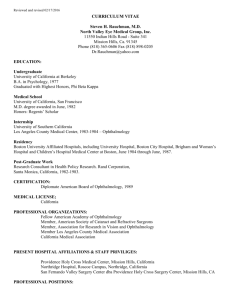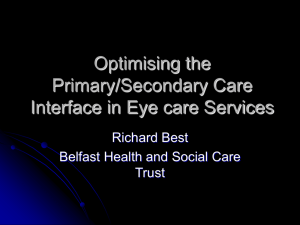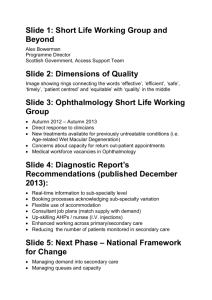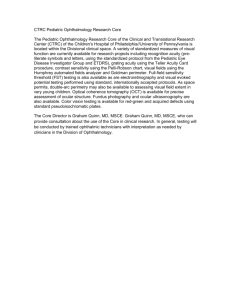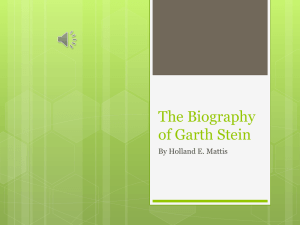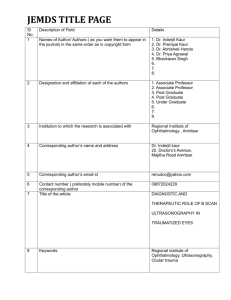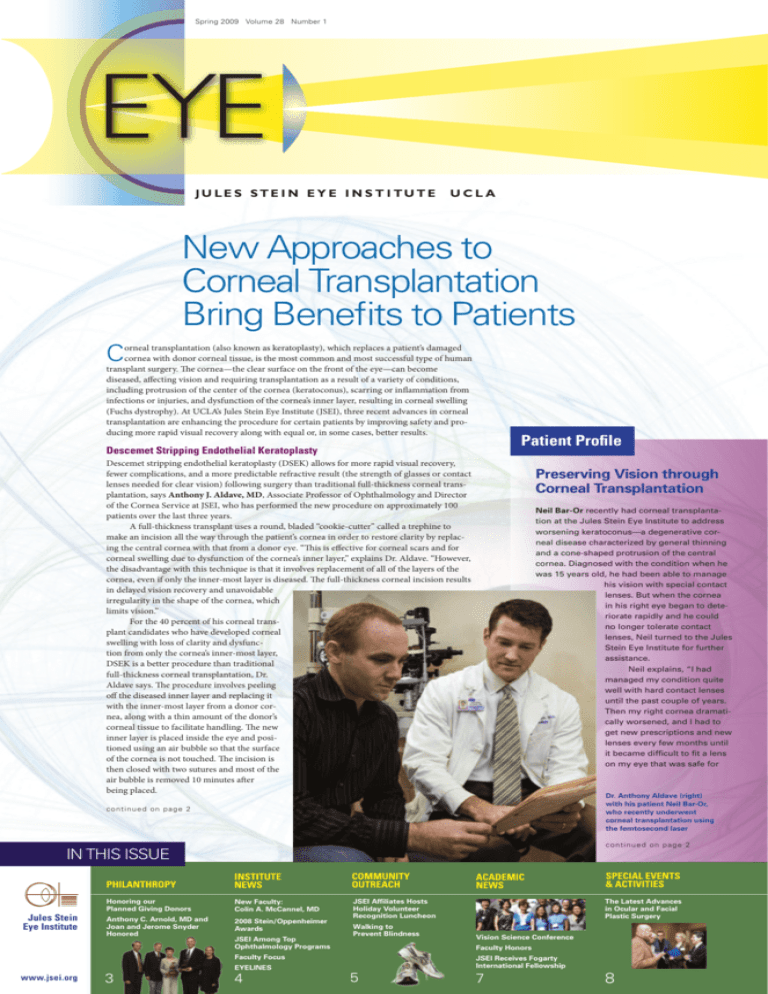
Spring 2009 Volume 28 Number 1
EYE
JU LE S STE I N E Y E I N S T I TUTE
UCLA
New Approaches to
Corneal Transplantation
Bring Benefits to Patients
C
orneal transplantation (also known as keratoplasty), which replaces a patient’s damaged
cornea with donor corneal tissue, is the most common and most successful type of human
transplant surgery. The cornea—the clear surface on the front of the eye—can become
diseased, affecting vision and requiring transplantation as a result of a variety of conditions,
including protrusion of the center of the cornea (keratoconus), scarring or inflammation from
infections or injuries, and dysfunction of the cornea’s inner layer, resulting in corneal swelling
(Fuchs dystrophy). At UCLA’s Jules Stein Eye Institute (JSEI), three recent advances in corneal
transplantation are enhancing the procedure for certain patients by improving safety and producing more rapid visual recovery along with equal or, in some cases, better results.
Patient Profile
Descemet Stripping Endothelial Keratoplasty
Descemet stripping endothelial keratoplasty (DSEK) allows for more rapid visual recovery,
fewer complications, and a more predictable refractive result (the strength of glasses or contact
lenses needed for clear vision) following surgery than traditional full-thickness corneal transplantation, says Anthony J. Aldave, MD, Associate Professor of Ophthalmology and Director
of the Cornea Service at JSEI, who has performed the new procedure on approximately 100
patients over the last three years.
A full-thickness transplant uses a round, bladed “cookie-cutter” called a trephine to
make an incision all the way through the patient’s cornea in order to restore clarity by replacing the central cornea with that from a donor eye. “This is effective for corneal scars and for
corneal swelling due to dysfunction of the cornea’s inner layer,” explains Dr. Aldave. “However,
the disadvantage with this technique is that it involves replacement of all of the layers of the
cornea, even if only the inner-most layer is diseased. The full-thickness corneal incision results
in delayed vision recovery and unavoidable
irregularity in the shape of the cornea, which
limits vision.”
For the 40 percent of his corneal transplant candidates who have developed corneal
swelling with loss of clarity and dysfunction from only the cornea’s inner-most layer,
DSEK is a better procedure than traditional
full-thickness corneal transplantation, Dr.
Aldave says. The procedure involves peeling
off the diseased inner layer and replacing it
with the inner-most layer from a donor cornea, along with a thin amount of the donor’s
corneal tissue to facilitate handling. The new
inner layer is placed inside the eye and positioned using an air bubble so that the surface
of the cornea is not touched. The incision is
then closed with two sutures and most of the
air bubble is removed 10 minutes after
being placed.
Preserving Vision through
Corneal Transplantation
Neil Bar-Or recently had corneal transplantation at the Jules Stein Eye Institute to address
worsening keratoconus—a degenerative corneal disease characterized by general thinning
and a cone-shaped protrusion of the central
cornea. Diagnosed with the condition when he
was 15 years old, he had been able to manage
his vision with special contact
lenses. But when the cornea
in his right eye began to deteriorate rapidly and he could
no longer tolerate contact
lenses, Neil turned to the Jules
Stein Eye Institute for further
assistance.
Neil explains, “I had
managed my condition quite
well with hard contact lenses
until the past couple of years.
Then my right cornea dramatically worsened, and I had to
get new prescriptions and new
lenses every few months until
it became difficult to fit a lens
on my eye that was safe for
Dr. Anthony Aldave (right)
with his patient Neil Bar-Or,
who recently underwent
corneal transplantation using
the femtosecond laser
con tinued on pa ge 2
co n t i n u e d o n p ag e 2
In this Issue
Jules Stein
Eye Institute
Philanthropy
Institute
news
Community
Outreach
Honoring our
Planned Giving Donors
New Faculty:
Colin A. McCannel, MD
Anthony C. Arnold, MD and
Joan and Jerome Snyder
Honored
2008 Stein/Oppenheimer
Awards
JSEI Affiliates Hosts
Holiday Volunteer
Recognition Luncheon
JSEI Among Top
Ophthalmology Programs
Walking to
Prevent Blindness
www.jsei.org
3
4
special events
& activities
The Latest Advances
in Ocular and Facial
Plastic Surgery
Vision Science Conference
Faculty Honors
Faculty Focus
EYELINES
ACADEMIC
news
JSEI Receives Fogarty
International Fellowship
5
7
8
Corneal Transplantation Benefits
continued from page 1
Patient Profile
co n t i n u e d f r o m p ag e 1
Dr. Sophie Deng is one of only a small number of ophthalmologists that perform deep anterior lamellar keratoplasty
with baring of Descemet membrane (DALK)—a new approach to corneal transplantation that preserves the patient’s
normal tissue.
In addition to a faster visual recovery, Dr. Aldave
notes, many of the complications associated with fullthickness transplantation—including suture-related
complications such as infections and induced irregular
astigmatism—are eliminated. Preliminary research also
indicates that the rejection rate is lower.
Deep Anterior Lamellar Keratoplasty
A newly developed complement to the DSEK is the deep
anterior lamellar keratoplasty with baring of Descemet
membrane (DALK), a selective transplant procedure
for patients with a corneal scar or the corneal disease
keratoconus, but who have normal endothelial cells
(the inner layer). Rather than the traditional method
of replacing the entire cornea, the DALK replaces only
the portion of the cornea that is diseased. The endothelium and the Descemet membrane (the membrane that
lies between the endothelium and the corneal stroma)
remain intact. In DALK, air is injected into the cornea to
create a “big bubble,” thereby separating or “baring” the
paper-thin Descemet membrane as the entire stroma is
being removed.
“DALK enables us to preserve the patient’s normal
tissue, which has the potential to result in faster healing and less rejection,” says Sophie X. Deng, MD, PhD,
Assistant Professor of Ophthalmology, who began performing the procedure early last year.
DALK appears to improve on penetrating keratoplasty (the traditional treatment for such patients) in
several key ways. “Because the surgeon doesn’t need to
enter into the anterior chamber of the eye, there is no risk
of damaging the intraocular tissues, such as the lens and
the iris, and there is less chance of intraocular infection,”
Dr. Deng notes. “In addition, because we don’t replace
the healthy endothelium, there will not be rejection and
failure of the endothelial cells that are critical to keeping
the cornea clear. Overall, it is a very big improvement.”
Another major advantage, Dr. Deng says, is that the
requirements of the donor tissue are much less stringent
than with the penetrating keratoplasty.
The downside to the DALK is that it can be highly
challenging; thus, few ophthalmologists perform it. JSEI’s
acquisition of a special high-speed laser, the femtosecond
laser that Dr. Deng began to use to perform penetrating
keratoplasty this fall, may also make DALK easier, Dr.
Deng explains. Rather than manually removing the thin
layer of stromal tissue at the beginning of the procedure,
Dr. Deng will be able to use the new femtosecond laser,
greatly reducing the operating time.
Penetrating Keratoplasty with
a Femtosecond Laser
The same laser technology is being used for the third
and newest approach to corneal transplantation at
UCLA, penetrating keratoplasty with a femtosecond
laser. The new laser—widely employed over the last
decade for making flaps in LASIK surgery—uses tiny,
ultra-fast energy pulses to make incisions in the cornea
for partial or full-thickness transplants, allowing the
surgeon to create precisely shaped incisions so that the
transplanted tissue fits into the cornea like interlocking
pieces of a puzzle.
“Traditional corneal transplantation involves
using a circular blade to make a full-thickness cut
through the cornea, removing that disc of tissue, and
replacing it with a disc of similar size prepared from
donor tissue,” says D. Rex Hamilton, MD, Assistant
Professor of Ophthalmology and Director of the UCLA
Laser Refractive Center. “With this new technology we
can create customized, contoured cuts with the laser on
both the donor and the recipient tissue such that the
two fit together in an interlocking fashion. This has the
potential for faster visual rehabilitation, less astigmatism and stronger wound healing.”
The procedure is most appropriate
for patients who have had no previous
transplants or incisional surgeries and
do not have dense corneal scars, says
Dr. Hamilton, who began performing the
procedure this fall. It is ideal for patients
with a clear cornea that simply has an
abnormal shape that affects their vision,
such as patients with keratoconus. “For
most primary surgeries, this femtosecond
laser approach will likely become the
standard of care in the future,” Dr.
Hamilton says.
“There are a wide variety of
patients who can benefit from surgery
with the femtosecond laser,” says
Dr. Aldave, who began performing
femtosecond laser-assisted penetrating
keratoplasty early last year. “As with the
DSEK, this gives us the potential to
dramatically decrease postoperative
astigmatism because of the precision of
the laser, as well as provide a stronger
wound that is more resistant to traumatic
opening. It’s too early to say whether
this will revolutionize corneal transplant
surgery, but the early results that have
been reported are quite promising.”
the cornea and also provided useful vision.
It got to the point that if I could tolerate a
lens on my eye, I couldn’t see well, or if I put
a lens on my eye and I could see, I couldn’t
tolerate it.“
Neil was first seen at the Jules Stein
Eye institute by Barry A. Weissman, OD,
PhD, Director of the Contact Lens Service.
When Dr. Weissman determined that fitting
lenses on Neil’s right eye was no longer
an option, he referred him to Anthony J.
Aldave, MD, one of the Institute’s corneal
transplantation specialists. Dr. Aldave identified Neil as a candidate for a new approach
to corneal transplantation that uses a femtosecond laser, instead of a circular blade, to
make incisions in the cornea and the transplanted tissue. Because the laser allows the
surgeon to make identical cuts in the donor
corneal tissue and the host tissue, they fit
together like pieces of a puzzle, potentially
resulting in faster recovery of vision, stronger healing and less astigmatism.
“What Dr. Aldave explained, and the
research that I did confirmed, is that with
this approach the healing is a lot quicker
and a lot stronger. And hopefully it will lead
to less astigmatism, which is common in
corneal transplantation,” says Neil. “The
jury is still out because I only had the surgery two months ago. My vision is already
better than it was without the contact
lenses before the surgery. When Dr. Aldave
removes the stitches, my vision should
improve even more!”
Dr. Rex Hamilton believes that, in the future, the corneal transplantation
femtosecond laser approach will become the standard of care for
primary surgery patients.
EYE | Jul es Stei n Eye Insti tute | Spri ng 2009 | Page 2
Ph i l a n t h r o p y
Honoring our Planned Giving Donors
Plummer was very active in
charitable causes and community projects during her lifetime, and with no living relatives, she decided to leave her
estate to several non-profit
organizations. Many years
ago, she developed a special
affection for JSEI, when it was
instrumental in saving the
eyesight of a close friend. This
important and meaningful
contribution from the Mary
E. Plummer Family Trust will
support various initiatives at
JSEI that have an immediate
funding need.
A similar significant
Richard and Ardis Armstrong left their estate to the Jules Stein Eye Institute.
bequest was received in 2007
nbeknown to the Jules Stein Eye Institute (JSEI),
from the Estate of Mr. J. Richard Armstrong and Mrs.
Mrs. Mary E. Plummer included JSEI as a benArdis Armstrong. Before their passings in 2006 at the
eficiary of her Trust in 1993. When she passed away in
ages of 96 and 94, respectively, the Armstrongs decided
June 2007 at the age of 91, she left a most generous gift
to leave their sizable estate, including their residence
to support JSEI’s mission to preserve sight and prevent
and personal property, to JSEI. Both natives of Southern
blindness.
California, Mr. and Mrs. Armstrong enjoyed a 73-yearMrs. Plummer and her husband, who predeceased
long marriage. Mr. Armstrong’s interests included
her, lived a quiet life in the house they designed and built
boating, world travel, ham radio and photography. He
high in the Verdugo Hills with commanding views. Mrs.
served on the USS Rotanin during World War II and
U
Creating Your Legacy
A bequest to JSEI is a wonderful way to meet your estate
planning goals while minimizing taxes and conserving more of
your estate for loved ones. And, you will have the satisfaction
of knowing you are helping patients and families. We have a
gift plan to fit your needs and philanthropic goals. Estate and
planned gifts come in many varieties: was admired for his good nature and integrity. Mrs.
Armstrong was the driving force in naming JSEI as the
beneficiary of the couple’s estate; their gift has established
a permanent endowment to support degenerative eye
diseases, such as age-related macular degeneration.
Bequests from donors, such as Mrs. Plummer and
the Armstrongs, provide an opportunity to create an
enduring personal legacy that will benefit JSEI for many
years to come. Bartly J. Mondino, MD, JSEI’s Director,
remarked, “We are extremely grateful for this generosity.
I realize many donors do not desire to have any recognition for their remarkable philanthropy, but, personally, I
do wish I had an opportunity to thank these special and
thoughtful individuals, as their gifts will greatly benefit
our programs today and far into the future.”
Although some donors designate a specific purpose
for their planned giving arrangements, many prefer them
as unrestricted in order to be utilized to support areas of
highest priority, once the bequest is realized. This flexibility is ideal, as JSEI’s funding needs change and evolve
over time with new scientific advances and the development of new treatment options. JSEI has been most
fortunate to receive generous restricted and unrestricted
bequests that provide valuable resources to continue its
achievements in widely respected vision research, prestigious educational programs, and comprehensive patient
care and outreach activities. We are most grateful for
such gifts that are created in this meaningful way.
Anthony C. Arnold, MD, and
Joan and Jerome Snyder Honored
� Bequest through a will
� Gift through a living trust or other non-charitable trust
� Charitable remainder trust
� Charitable lead trust
� Pooled income fund gift
� Charitable gift annuity
� Remainder interest in a personal residence or
other real property
�Gift of life insurance
�Beneficiary designation in retirement plans
To explore the opportunities and rewards of giving to the Jules
Stein Eye Institute, please contact the Development Office at
(310) 206-9701 or visit our website at www.jsei.org. We work
with each donor to create a distinctive gift that blends financial
and personal objectives with priorities for JSEI. The result is
a gift that is personally satisfying and is mutually beneficial to
the donor and the Jules Stein Eye Institute.
Charitable IRA Rollover Extension
Good news! The popular IRA Charitable Rollover created under the Pension
Protection Act of 2006 has been extended. Individuals who are 70½ years of age
and older may make tax-free distributions from their traditional or Roth IRAs to
charity. Donors may instruct their IRA plan administrators to directly distribute to
a public charity up to $100,000 in each of the years 2008 and 2009, regardless of
income. While donors cannot claim a charitable deduction for IRA gifts, they will
not pay income tax on the amount, and the distribution will count toward their
minimum required distribution.
For more information on ways to take advantage of this opportunity and
support Jules Stein Eye Institute programs, please call the UCLA Office of Gift
Planning at (800) 737-UCLA or the JSEI Development Office at (310) 206-9701.
From left, Dr. Bartly Mondino, Jerome and Joan Snyder, and Dr. Anthony Arnold
and his wife Dr. Laura Bonelli, celebrate the establishment of the Snyder Chair.
O
n October 2, 2008, Jules Stein Eye Institute Director,
Bartly J. Mondino, MD, presented the David Geffen
School of Medicine at UCLA recognition chairs to donors
Joan and Jerome Snyder in appreciation for their generous pledge to establish the Jerome and Joan Snyder Chair in
Ophthalmology. This endowment, established in 2007, supports the activities of a distinguished faculty member who
directs the UCLA Ophthalmology Residency Program.
The occasion also provided a wonderful opportunity
to congratulate Anthony C. Arnold, MD, on his appointment to this prestigious chair. Dr. Mondino remarked, “The
acquisition of an endowed chair for our Residency Program
Director has long been one of my priorities, and I am
incredibly grateful for Joan and Jerry’s outstanding investment. Tony is a devoted teacher, mentor and clinician who
will bring great honor to this important position.”
EYE | Jul es Stei n Eye Insti tute | Spri ng 2009 | Page 3
Institute News
New Faculty
Colin A. McCannel, MD
It is a great pleasure to announce that Colin A. McCannel, MD, has been appointed Associate
Professor of Ophthalmology in the Retinal Disorders and Ophthalmic Genetics Division at UCLA’s
Jules Stein Eye Institute, effective October 15, 2008.
Dr. McCannel received his medical training from the Mayo Medical School in Rochester,
Minnesota. He completed his ophthalmology residency training, and two-year vitreoretinal surgery
fellowship at the Jules Stein Eye Institute, David Geffen School of Medicine at UCLA. His fellowship
was followed by more than 10 years of service as a Consultant and staff vitreoretinal surgeon in the
Department of Ophthalmology at the Mayo Clinic. Prior to his recruitment to UCLA, he held the
academic title of Associate Professor of Ophthalmology at the Mayo Medical School.
Dr. McCannel comes to the Jules Stein Eye Institute with outstanding qualifications. He has
written more than 40 peer-reviewed articles, served as President of the Minnesota Academy of
Ophthalmology, and is the recipient of several honors, most recently the “Innovation in Education”
award from the Mayo School of Continuing Medical Education.
During his time at the Mayo Clinic, he developed an international reputation as a leader in
the field of vitreoretinal surgery and paramount surgeon. His clinical focus is the management of
vitreoretinal surgical problems, particularly complex retinal detachments, complications of diabetic
retinopathy, macular holes, epimacular membranes (puckers), and age-related macular degeneration.
At the Jules Stein Eye Institute, Dr. McCannel will be leading an initiative to implement surgical simulation technology to improve the surgical training of ophthalmology residents and vitreoretinal surgery fellows. As part of this teaching commitment, he will be Chief of Retina at Harbor-UCLA
Medical Center. His other research interests include surgical techniques, epidemiologic studies and
outcomes research. He will use his talents and experience to further improve patient care.
Please join us in welcoming Dr. McCannel back to the Jules Stein Eye Institute. His clinical and
research activities will greatly contribute to our understanding and improvement of the medical and
surgical treatment of vitreoretinal diseases.
2008 Stein/Oppenheimer Awards
On October 16, the 18th annual reception for the Stein/Oppenheimer Endowment
Fund was held at the Jules Stein Eye Institute (JSEI) to highlight the research findings
of the 2008 award recipients. Mr. Gerald (Jerry) H. Oppenheimer, JSEI Board Trustee,
established this program in 1990 to further medical research, education and patient care
at the UCLA Center for the Health Sciences. This funding enables scientists, clinicians
and others to generate preliminary data to use in subsequent applications to federal and
private funding sources. Since the program’s inception, an investment of approximately
$4.1 million has generated more than $82 million in new research grants to UCLA, a
20-fold return.
In 2002, Gail and Jerry Oppenheimer launched the Center for Prevention of Eye
Disease Program as a part of the Stein/Oppenheimer Awards, which provides seed
grants to researchers working to prevent ophthalmic diseases. Areas of study include
genetic and environmental factors that may cause eye disease and pharmacological
and natural agents to treat eye problems before they happen. JSEI Director Bartly J.
Mondino, MD, remarked, “Thanks to the Gerald Oppenheimer family, vision science
researchers and clinicians are given a unique opportunity to engage in pioneering and
very promising investigations that may ultimately lead to steps we can take to avoid
vision loss and maintain healthy eyes.”
Novrouz Akhmedov
(right) explains his
research on retinitis
pigmentosa at the
Stein/Oppenheimer
Endowment Fund
reception.
From left, Dr. Leonard
Rome, Senior Associate
Dean of Research, David
Geffen School of Medicine at UCLA, Gail and
Gerald Oppenheimer,
and Dean Gerald Levey
The 2008 grant award recipients in the Center for Prevention of Eye Disease
Program include:
Novrouz Akhmedov, PhD
Assistant Researcher in
Ophthalmology
Debora B. Farber, PhD,
DPhhc
Karl Kirchgessner Professor
of Ophthalmology
Novel Locus for Retinitis
Pigmentosa Associated
with the Recently Identified
7R Protein
Anthony J. Aldave, MD
Associate Professor of
Ophthalmology
RNA Interference
Targeting of the TGFBI
Gene Transcript in Human
Corneal Epithelial Cells
as a Method to Inhibit
Pathologic TGFBI Protein
Deposition in the Corneal
Dystrophies
James W. Bisley, PhD
Assistant Professor of
Neurobiology
Member, Jules Stein Eye
Institute
The Influence of Posterior
Parietal Cortex on Visual
Processing
Peter J. Bradley, PhD
Assistant Professor of
Microbiology, Immunology,
and Molecular Genetics
Characterization of an
Avirulent Mutant of
Toxoplasma Gondii, the
Causative Agent of Ocular
Toxoplasmosis
Lucy Q. Shen, MD
Clinical Instructor in
Ophthalmology
Anne L. Coleman, MD,
PhD
Frances and Ray Stark
Professor of Ophthalmology
Professor of Epidemiology
Director of the UCLA Center
for Eye Epidemiology and
the UCLA Mobile Eye Clinic
Dietary Vitamin Intake and
Open Angle Glaucoma: A
Case-Control Study
JSEI Among Top Ophthalmology Programs
The Jules Stein Eye Institute (JSEI) is among the top ophthalmology programs
in the United States in the 2008 survey of Best Programs by Ophthalmology
Times. Published on October 15, 2008, survey results were tabulated from a
poll of U.S. ophthalmology chairpersons and residency directors.
JSEI ranked fifth in the Best Overall Program category for outstanding
work in teaching and developing residents into the nation’s up-and-coming
ophthalmologists, educating the public about eye care, and embracing and
promoting the philosophy of continued research among professional staff.
The Institute also garnered high marks for other categories surveyed, ranking
among the top 10 nationally for both Best Clinical (Patient Care) Programs and
Best Research Programs.
Alexander M. van der
Bliek, PhD
Associate Professor of
Biological Chemistry
Screen for Small Molecules
that Slow Dominant Optic
Atrophy
EYE
|
Jul es Stei n Eye Insti tute
|
Spri ng 2008
|
Page 4
www
Faculty Focus
What do you most enjoy about your work?
After all of these years, I still enjoy working in the laboratory “at the bench.” I
don’t get to do that very much anymore. It’s great to see results, but digging in
and doing the work is my greatest joy. I also love to teach. I currently teach two
courses. One is an undergraduate course with about 250 students. The other is a
course that I designed in 1989 for the graduate curriculum.
What is your most important contribution to the field?
Dr. Dean Bok (right) relaxing at the Lake Michigan sand
dunes with a former college classmate. Dean Bok, PhD
Dolly Green Professor of Ophthalmology
Professor of Neurobiology
Director, Retinal Cell Biology Laboratory
Dean Bok, PhD, who recently completed his 40th year at the Jules Stein Eye
Institute (JSEI), refers to himself as the “elder scientist “on the active basic science
faculty. His career at UCLA started more than 44 years ago when he responded
to an ad for graduate school stipends in the Department of Anatomy. He applied,
joined a laboratory that was studying the eye, and so impressed Bradley R.
Straatsma, MD, JD, JSEI Founding Director and member of his PhD dissertation
committee, that he was offered a position at the Institute. Today Dr. Bok is a recognized scientist in the field of inherited retinal diseases, and it is a discovery that he
made early in his career that provided critical information for understanding how
these diseases work and might be addressed therapeutically.
We asked Dr. Bok about his work as a vision scientist and what he likes to do
when he’s not in his laboratory or teaching.
I guess I’m most proud of the discovery that I made with my professor, Richard
Young, when I was just starting my career. We determined that the light-sensing
cells in the retina, called photoreceptors, manage to survive in a very toxic environment by every day manufacturing and then throwing away about one-tenth of
the light-sensitive antennae that we use for vision. The discovery that photoreceptors are in a very dynamic state, constantly renewing their light-sensitive components, was very exciting. We published that fundamental observation in 1969,
but it still has application today. In fact, the process that we described proved to
be a key to understanding the underlying cause of an early onset form of macular
degeneration called Stargardt disease, one of the inherited retinal diseases that
I’m currently studying. So it’s satisfying to make a very fundamental discovery and
see that discovery translated into information that can be useful in understanding
how diseases work and how they might be treated or prevented.
What would you still like to achieve professionally?
Well I’d like to come up with one new concept that others can build on. I don’t
know if that will happen at this stage in my career, but it would be great.
What do you like to do when you’re not at work?
I was born and raised on a farm, so I like to spend time outdoors and do physical work. Aside from staying at home and gardening in my backyard, I enjoy desert camping in the winter—when it’s clean, beautiful and there are no bugs—and
going to our place in Mammoth with my family in the summer. My wife and I also
enjoy traveling abroad. Each year we take one major trip together to a foreign
country, which we usually coordinate with one of the conferences or meetings
that I attend.
EYELI NES
More than 150 Jules Stein Eye Institute (JSEI) faculty
members, staff, and resident and fellow alumni from
around the world gathered at the Ritz Carlton in Atlanta,
Georgia, on Sunday, November 9, 2008, for the UCLA
Department of Ophthalmology Association’s annual
reception. The reception provides an opportunity for
alumni attending the annual American Academy of
Ophthalmology meeting to renew acquaintances and
reconnect with classmates. Graduates from close to 30
different JSEI graduating classes were represented at this
year’s event.
JSEI faculty member Dr. Lynn
Gordon (second from left) greets
(left to right) Dr. P.J. Kappel,
uveitis fellow and resident
alumnus from the class of 2007,
Dr. Roberta Costa, neuro-ophthalmology international fellow, and
Dr. Raquel Goldhardt, international fellow alumna.
Drs. Tina Rutar (left)
and Adrienne Ruth,
pediatric division
fellow alumni
Emeritus faculty
member Dr. Allan
Kreiger (left) welcomes
retina fellow alumnus
Dr. Maurice Syrquin.
JSEI faculty member Dr. Robert
Goldberg celebrates the evening
with Dr. Tanvi Shah, a JSEI thirdyear resident.
Additional photos from
the Alumni Reception
can be found online at
www.jsei.org.
Dr. Tania Tai (left), JSEI thirdyear resident, and Dr. Stacy
Pineles, pediatric fellow and
resident alumna from the
class of 2008
From left, Drs. Jared Younger and My Hanh Nguyen, cornea
fellow alumni, are greeted by JSEI faculty member Dr. Richard
Casey.
EYE | Jul es Stei n Eye Insti tute | Fal l 2008 | Page 5
Special Thanks to JSEI
Alumni and UCLA Department
of Ophthalmology Association
Members!
The UCLA Department of Ophthalmology
Association extends a special thank you
to its 2008–2009 dues paying members.
Annual dues provide the Association
with the resources to support the annual
Research Grant Awards, the JSEI Clinical
and Research Seminar, the Video Library
Project, the Alumni Directory, the
Reception at the Annual AAO Meeting
and other important alumni events.
We greatly appreciate your continued support of the UCLA Department
of Ophthalmology Association and the
Jules Stein Eye Institute. If you have not
yet submitted your dues and would like
to do so, registration forms can be found
online at www.jsei.org or requested by
contacting us at alumni@jsei.ucla.edu.
Thank you!
Community Outreach
JSEI Affiliates Hosts
Holiday Volunteer Recognition Luncheon
Preschool Vision Screening volunteer and
Affiliates Board Member Robyn Travis
(left) and Volunteer Coordinator Judy
Smith
Cherie Hubbell, Chair of the JSEI Affiliates, hosted the organization’s Ninth
Annual Holiday Luncheon on Monday, December 8, 2008, at the Hotel BelAir honoring the JSEI Affiliates Advisory Board members, program volunteers and special guests.
“The strength of the JSEI Affiliates programs depends
on our dedicated volunteers whom we recognize at this
special annual recognition event,” Hubbell remarked. “The
Affiliates accomplished new levels this year in each of our
community outreach programs—results that would not
have been possible without the commitment of our advisory board and dedication of our volunteers.”
The Affiliates offers the Vision In-School program
and Preschool Vision Screenings free of charge to elementary schools and preschools in the community. It also supports several patient programs including the Make Surgery
Bearable and Shared Vision programs, providing Dr. Teddy MD teddy bears
to JSEI pediatric surgery patients and donated refurbished eyeglasses to adults
and children who could not otherwise afford them.
If you would like more information about joining or volunteering with
the Jules Stein Eye Institute Affiliates, please contact the Jules and Doris Stein
UCLA Support Group at (310) 825-4148.
Preschool Vision Screening volunteers
(left to right) Drs. Louis Rosenberg,
Leonard Apt and Jule Lamm
Outreach Manager Teresa Closson (left)
and program volunteer Sandra Fiala
“The Affiliates accomplished
new levels this year in
each of our community
outreach programs—
results that would not have
been possible without the
commitment of our advisory
board and dedication of
our volunteers.”
Special Thanks to
Dr. Teddy Holiday Donors!
From left, Judy Smith, program
volunteer Erica Farber, Development Director Nancy Graydon and
John Laione
From left, JSEI Affiliates President Cherie
Hubbell and long term volunteers Sandra Allan
and Ruth Straatsma
The JSEI Affiliates thanks its many
special donors who contributed to the
annual Make Surgery Bearable Holiday
Sponsorship Campaign. The campaign
raised funds to sponsor over 150 Dr.
Teddy MD teddy bears for pediatric
surgery patients at the Jules Stein Eye
Institute. Dr. Teddy sponsorships can
be submitted year round in honor or
memory of a loved one, or to celebrate
anniversaries or birthdays. Contact
the JSEI Affiliates at (310) 825-4148
or www.jseiaffiliates.com for further
information.
Walking to Prevent Blindness
JSEI Faculty Members Dr. Robert Goldberg (second from left) and Dr. JoAnn Giaconi (center)
are joined by, from left, Drs. Jan Takasugi, Sadiqa Stelzner, and Alpa Patel, and in front
Hannah Stelzner.
Several hundred walkers descended upon UCLA’s
Dickson Court on Sunday, October 26, 2008, for the
Foundation Fighting Blindness’ (FFB) Second Annual
VisionWalk. The event, supported by both the Jules
Stein Eye Institute (JSEI) and volunteers from the
JSEI Affiliates, raised more than $80,000 for retinal
eye disease research.
Walkers participating on the JSEI team donned
matching “Volunteers with Vision” t-shirts and
strolled the 5-kilometer loop though UCLA’s beautiful north campus along with approximately 450 other
participants. JSEI staff member and program volunteer Teresa Closson joined the JSEI walkers with her
daughter Lauren and yellow Labrador Roxy. “This
is the second year we have participated. VisionWalk
is a very inspirational event and a wonderful way to
spend a Sunday morning.”
The Foundation Fighting Blindness is a nonprofit organization committed to funding research to
prevent, treat and cure retinal degenerative eye diseases. The Jules Stein Eye Institute, a lead sponsor
of VisionWalk, participates in research on a number
of inherited retinal diseases and has received FFB
funding for continued study of vision loss treatment
and prevention.
EYE | Jul es Stei n Eye Insti tute | Spri ng 2009 | Page 6
Academic News
Vision Science Conference
On October 24–26, 2008, over 80 basic scientists and
clinical researchers gathered for the Fourteenth Annual
Vision Science Conference at the UCLA Conference
Center in Lake Arrowhead, California. The event was
sponsored by the National Eye Institute Vision Science
Training Grant and the Jules Stein Eye Institute (JSEI).
The attendees enjoyed scientific discussions and social
events near the beautiful backdrop of Lake Arrowhead.
Highlighting the weekend was a presentation by
keynote speaker Nathan L. Mata, PhD, Senior Vice
President and Chief Scientific Officer from SIRiON
Therapeutics. Dr. Mata spoke about drug development
in the area of macular degeneration. The group also
discussed animal ethics led by speakers Andy Perkins,
Assistant Director of the Animal Research Committee,
and Joanna Zahorsky-Reeves, Clinical Veterinarian
of the Department of Laboratory Animal Medicine, at
UCLA. There were an additional 29 presentations highlighting the research from 17 JSEI laboratories. These
speakers spurred discussion and created an opportunity
for new collaborations amongst Institute researchers.
Ned Van Eps, PhD, and Quan Yuan, PhD, received the
best poster and presentation award respectively.
This year’s conference planning committee
included Committee Chair Nathaniel Roybal, MD, PhD,
as well as Anna Matynia, PhD, Bryan Chen, Carlos
Lopez, Jiamei Yu, PhD, Khumar Gangalum, PhD,
Lawrence Yoo, Louise Hughes, PhD, Mike Woodruff,
PhD, and Vanda Lopes, PhD; the Vision Science
Grant Coordinators Nora Momoli and Linda Kemp;
Committee Advisor Bill Dominguez; and Committee
Faculty Advisor Suraj Bhat, PhD.
Over 80 basic scientists
and clinical researchers
attended the Fourteenth
Annual Vision Science
Conference in Lake
Arrowhead, California.
JSEI Fellow Receives Fogarty
International Fellowship
Fogarty International Clinical Research Fellowship
recipient Dr. Oluwatoyin Fafowora (center) with mentors
Drs. Michael Gorin and Anne Coleman.
Oluwatoyin Fafowora, MD, MPH, Post-doctoral
Fellow at the Jules Stein Eye Institute (JSEI),
received a Fogarty International Clinical Research
Fellowship to study the genetics of juvenile open
angle glaucoma in Ibadan, Nigeria. The announcement was made by the Fogarty International
Scholars Support Center, National Institutes of
Health, on July 25, 2008. Under the mentorship
of JSEI Ophthalmology Professors Michael B.
Gorin, MD, PhD, and Anne L. Coleman, MD, PhD,
and in collaboration with her foreign counterpart
Adeyinka Ashaye, MD, Dr. Fafowara will build a
2,000-person cohort from Nigerian families with a
history of juvenile open angle glaucoma (JOAG).
The cohort will provide the basis for a series of
studies to evaluate the pattern of inheritance,
family risk, and variable expression and penetrance of JOAG.
Faculty Honors
Anthony J. Aldave, MD,
Associate Professor of
Ophthalmology, and David
Sarraf, MD, Associate Clinical
Professor of Ophthalmology,
received Secretariat Awards
from the American Academy of
Ophthalmology in July 2008. The
Secretariat Award recognizes
ophthalmologists for special
contributions to the Academy
and ophthalmology. The
Academy also honored Clinical
Professor of Ophthalmology
Michael S. Berlin, MD, and
Associate Clinical Professor of
Ophthalmology Donald S. Fong,
MD, by presenting them with
Senior Achievement Awards
David May II Professor of
Ophthalmology Joseph Caprioli,
MD, was a Distinguished
Keynote Speaker at the Annual
Meeting, “Glaucoma: Reality
and Perspectives,” sponsored
by the Russian Academy of
Medical Sciences, State Institute
of Eye Diseases, in Moscow, on
September 25–26, 2008.
Joseph L. Demer, MD,
PhD, Leonard Apt Professor of
Ophthalmology, presented the
Gunter K. von Noorden Lecture
at the Cullen Eye Institute,
Baylor College of Medicine, in
Houston, Texas, on October
16, 2008. The Lecture focused
on new methods for treatment
of strabismus by surgery on
the orbital connective tissues,
including the pulleys.
On September 13,
2008, Laraine and David
Gerber Professor of Pediatric
Ophthalmology Sherwin J.
Isenberg, MD, was honored by
being named President-Elect
of the Costenbader Pediatric
Ophthalmology Society.
Costenbader is the oldest
Pediatric Ophthalmology Society
in the world and the second
largest Pediatric Ophthalmology
society in North America.
At the World Ophthalmology Congress in Hong Kong,
China, on June 28–July 2, 2008,
Bradley R. Straatsma, MD, JD,
Founding Director and Professor
Emeritus of Ophthalmology,
was elected an Honorary Life
Trustee of the International
Council of Ophthalmology.
Dr. Straatsma has served the
Council in several capacities
and has been a Board Member
since 1993. Dr. Straatsma is also
President of the International
Council of Ophthalmology
Foundation, the support organization for International Council
of Ophthalmology programs of
education and public service
worldwide.
H O N O R S
EYE | Jul es Stei n Eye Insti tute | Fal l 2008 | Page 7
Special Events
The Latest Advances
in Ocular and
Facial Plastic Surgery
On Tuesday, November 18, 2008, Robert Alan
Goldberg, MD, Karen and Frank Dabby Professor of
Ophthalmology and Chief of the Orbital and Ophthalmic
Plastic Surgery Division, hosted a medical forum at the
Jules Stein Eye Institute (JSEI). Entitled “Finding the
Fountain of Youth,” the forum focused on new horizons
in vision research and surgical innovations in the area of
ocular and facial plastic surgery.
If you are interested in receiving information about
this event or upcoming medical forums, please contact
the JSEI Development Office at (310) 206-6035.
Director Emeritus, Dr. Bradley R. Straatsma,
and Mrs. Gail Oppenheimer chat following the
presentation.
From left, Arline and Ronald Goldberg with their son Robert, and Irving and Esther Zabin
Dr. Robert Goldberg (left) with
Dr. Leonard Apt, Professor of
Ophthalmology Emeritus and
Founding Chief of the Division
of Pediatric Ophthalmology
and Strabismus
From left, loyal supporter Richard Nelson Matthews with Paul Tasker,
Peter Catham, Sharon Douglas Tanji, Deputy Director, Medical Sciences
Development, and featured speaker, Dr. Robert Goldberg
JSEI supporter Donald Clause with
Ronnie Kassorla
Important JSEI Phone Numbers
Patient Care
JSEI Ophthalmology Referral Service
JSEI Ophthalmology Emergency Service
after hours (310) 825-5000
(310) 825-3090
(310) 825-2111 Fund Raising
JSEI Development Office
(310) 206-6035
JSEI Affiliates
(310) 825-4148
EYE
EYE Newsletter
Non-Profit Org.
U.S. Postage
PAID
UCLA
Jules Stein Eye Institute
is a Publication of
Jules Stein Eye Institute
Director
Bartly J. Mondino, MD
Editors
Debora B. Farber, PhD, DPhhc
Gary N. Holland, MD
Managing Editor
Gloria P. Jurisic
Contributing Editors
Irene Chen
Teresa Closson
Nancy Graydon
Debbie Sato
Guest Writer
Dan Gordon
Contributing Photographers
Reed Hutchinson
J. Charles Martin
UCLA Photography
Design
Robin Weisz/Graphic Design
© 2009, by The Regents of the
University of California.
All rights reserved.
(310) 206-6035
www.jsei.org
100 Stein Plaza, UCLA
Box 957000
Los Angeles, California, 90095-7000
U.S.A.
Forwarding Service Requested


